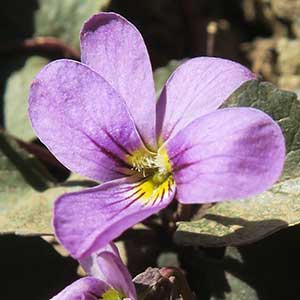Viola flettii
Viola missouriensis
Flett's violet, Olympic violet, rock violet
Missouri violet
1–3, ascending to erect, mostly glabrous, on caudex from fleshy rhizome.
basal and cauline;
basal: 1–3;
stipules linear-lanceolate, margins entire or with glandular processes, apex acuminate;
petiole 1.5–9.7 cm, mostly glabrous;
blade purple-tinted and –veined, broadly reniform to ovate, 0.9–2.4 × 1.2–4 cm, base cordate, margins finely crenate-serrate, eciliate, apex acute to obtuse, surfaces glabrous or sparsely pubescent along veins adaxially;
cauline similar to basal except: stipules ovate to lanceolate, margins entire or shallowly laciniate;
petiole 0.7–5.9 cm, usually glabrous;
blade 0.8–2.1 × 1.2–3.1 cm.
basal, 1–8, ascending to erect;
stipules linear-lanceolate to broadly lanceolate, margins entire, sometimes distally glandular, apex acute;
petiole 5–20 cm, glabrous;
blade green abaxially, unlobed, usually narrowly to broadly deltate, 1.5–12 × 1.5–10 cm, not fleshy, base cordate or broadly cordate to truncate, margins ± crenate to serrate, ciliate or eciliate, apex acute to acuminate, surfaces glabrous, rarely pubescent.
1.8–7.1 cm, usually glabrous.
3–25 cm, usually glabrous.
sepals lanceolate, margins eciliate, auricles 0.5–1.5 mm;
petals soft reddish violet on both surfaces, all with yellow area basally, lower 3 dark violet-veined, lateral 2 bearded, lowest with white around yellow area, 10–15 mm, spur yellow, gibbous, 0.5–2 mm;
style head bearded; cleistogamous flowers axillary.
sepals lanceolate to ovate, margins ciliate or eciliate, auricles 1–2 mm;
petals light to dark blue-violet, lowest and sometimes lateral 2 purple-veined, lateral 2 bearded, lowest beardless, rarely lightly bearded, 15–25 mm, spur same color as petals, gibbous, 2–3 mm;
style head beardless; cleistogamous flowers on prostrate to ascending peduncles.
± spherical, 5–9 mm, glabrous.
ellipsoid, 5–12 mm, glabrous.
dark brown to brownish purple, 2.5–3 mm.
beige, mottled to bronze, 1.5–2.5 mm.
= 54.
Viola flettii
Viola missouriensis
Viola flettii is endemic to the Olympic Mountains of northwestern Washington. C. S. McCreary (2005) noted that although morphologically and ecologically distinct, V. cuneata, V. flettii, and V. ocellata are closely related.
(Discussion copyrighted by Flora of North America; reprinted with permission.)
What many have treated as Viola affinis, especially in the southern Gulf coastal states, is likely to be V. missouriensis. N. H. Russell (1965) considered the two as likely part of a species complex inhabiting alluvial woods and wet areas and exhibiting the typical deltate leaf blade shape. L. E. McKinney (1992) considered V. missouriensis a variety of V. sororia. Viola missouriensis appears to have a closer affinity to V. affinis, as Russell suggested; current evidence suggests maintaining V. missouriensis as a separate species.
(Discussion copyrighted by Flora of North America; reprinted with permission.)


